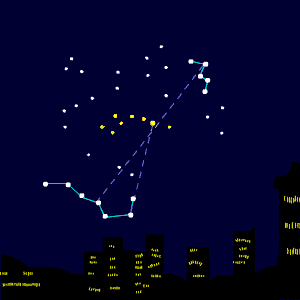Fitxategi:Zirkumpolar ani.gif
Vikidiatik
Nabigaziora joan
Bilaketara joan
Zirkumpolar_ani.gif (300 × 300 pixel, fitxategiaren tamaina: 172 KB, MIME mota: image/gif, kiribildua, 150 irudi, 6,0s)
Oharra: muga teknikoak direla eta, erresoluzio handiko GIF irudi hau bezalakoak ez dira animatuak izango.
Fitxategi hau Wikimedia Commons biltegikoa da, eta beste proiektu batzuetan erabil daiteke. Behean dago fitxategiaren deskribapeneko orria.
| DeskribapenaZirkumpolar ani.gif | Circumpolar stars |
| Data | |
| Jatorria | made by me (Flash) |
| Egilea | user:Mjchael |
| Lizentzia (Fitxategi hau berrerabiltzen) |
Nik, lan honen egileak, argitaratzen dut ondorengo lizentzia pean: This file is licensed under the Creative Commons Attribution-Share Alike 2.5 Generic license.
|
ursprünglich gezeichnet für (primary for): de.Wikibooks.org - Advendskalender 2006
Deutsch: Von großer Bedeutung für die geografische Orientierung waren seit jeher bestimmte Sternbilder der Zirkumpolarregion.
- Der kleine Wagen ist nicht so leicht auszumachen wie seine größeren Nachbarn „Großer Wagen“ und „Cassiopeia“.
- Der kleine Wagen (und damit auch der Polarstern) befindet sich in etwa in der Mitte zwischen dem Sternbild Cassiopeia und dem großen Wagen.
- Die Strecke zwischen den zwei hinteren Kastensternen des großen Wagens wird fünf mal verlängert, um auf die Position des Polarsterns zu kommen.
- Das Sternbild Cassiopeia wird auch Himmels-W genannt.
- In der Animation leuchten die Sternbilder kleiner Wagen, Cepheus und Drache kurz gelb auf.
English: Since ancient times, the constellations visible from the northern circumpolar region were of great importance for geographical orientation. In the animated diagram you can see how to find the north polar star, or Polaris as it is commonly known. It may be seen from almost anywhere in the northen hemisphere.
- Polaris sits in the middle of the Great Bear and Cassiopeia (note the long dashed line) and is actually part of the constellation 'Little Bear'. If you can find Cassiopeia and the Great bear you should be able to find Polaris. It is not absolutely necessary, to find at first the constellation 'Little Bear', because often it will not be discovered before Polaris was found, and not vice versa. Ultimately (for example, at a slightly cloudy sky) is not even necessary at all to find the North Star to determine safely the cardinal direction north.
- The Little Bear is not as easy to find as its larger neighbours – the 'Great Bear' and 'Cassiopeia', both of which are much easier to identify.
- Cassiopeia may appear in a form of a letter 'W' or 'M'.
- The Little Bear sits between the Great Bear and Cassiopeia. Some people find it easy to imagine the two 'Bear' constelations as looking rather like saucepans or ladles. This is convenient because the star at the end of the Little Bear's 'handle' is Polaris – the North or Pole star.
- The Great and Little Bears are often known as the 'Big Dipper' and the 'Little Dipper' – another reference to their ladle-like appearance.
- In German the Little Bear its also known as "Small Barrow (Kleiner Wagen). By extension of the whiffletree on the fivefold you will also lead to the Polaris (note the small dashed line).
- In the animation, The Little Bear and two other constellations Cepheus and Draco light up briefly in yellow.
Irudi-oineko testuak
Add a one-line explanation of what this file represents
Circumpolar stars: Circuitolar constellations of the northern hemisphere: The auxiliary lines show how to find the polar star and thus determine the direction of heaven north.
Zirkumpolarsternbilder der nördlichen Hälfte der Erde: Die Hilfslinien zeigen, wie man den Polarstern finden und damit die Himmelsrichtung Nord bestimmen kann.
Fitxategi honetan agertzen diren itemak
honako hau irudikatzen du
azaroa 2006
Fitxategiaren historia
Data/orduan klik egin fitxategiak orduan zuen itxura ikusteko.
| Data/Ordua | Iruditxoa | Neurriak | Erabiltzailea | Iruzkina | |
|---|---|---|---|---|---|
| oraingoa | 03:10, 1 abendua 2006 |  | 300 × 300 (172 KB) | wikimediacommons>Mjchael |
Fitxategiaren erabilera
Fitxategi hau darabilte ondorengo 2 orri hauek:
"http://eu.vikidia.org/wiki/Fitxategi:Zirkumpolar_ani.gif"(e)tik jasota
